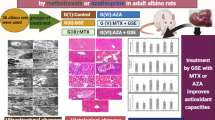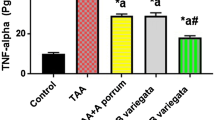The present study was aimed to investigate a protective effect of polysaccharide rich fraction from Eulophia herbacea Lindl. tubers against methotrexate (MTX) induced liver damage in rats. The polysaccharide-rich extract fraction of E. herbacea (PEEH) was isolated from tubers by maceration and then evaluated for its hepatoprotective effect on MTX induced liver damage in rats through measurement of the liver enzymes function and the levels of proinflammatory cytokines and antioxidants. A group of 30 Wistar albino rats were randomly selected and divided into five groups, each containing six rats. Normal control group received saline, negative control group received MTX (20 mg/kg, i.p.) at a single dose, and test groups received MTX (20 mg/kg, i.p.) followed by the PEEH fraction at 100 and 200 mg/kg (p.o.) for four days. Silymarin (100 mg/kg, p.o.) was used as standard for comparison. Biochemical analysis and histological examinations of liver were performed on the fifth day. The PEEH fraction contains 26.71 mg glucomannan per gram of tubers, as estimated by HPTLC method. Results of this study confirmed that PEEH treatment led to significantly reduced (P ≤ 0.01) level of liver enzymes (ALP, ALT and AST) that improved the liver function. PEEH was also able to improve the activity of liver antioxidants (GSH, SOD and CAT), decrease lipid peroxidation, and restore it to a normal level. This was an indication of decreasing oxidative stress caused by MTX. PEEH treatment (100 and 200 mg/kg) significantly reduced the level of proinflammatory cytokines (P ≤ 0.01) in dose-dependent manner. These effects were confirmed by histological examination of the liver. In conclusion, polysaccharide rich fraction of E. herbacea tubers showed liver protection effect through reduction of the oxidative stress and produced an anti-inflammatory action.







Similar content being viewed by others
References
J. Sun, B. Zhou, C. Tang, et al., Int. J. Biol. Macromol., 115, 69 – 76 (2018).
A. A. El Faras and A. L. Elsawaf, Tanta Med. J., 45(2), 92–98 (2017).
C. V. Rao, A. Singh, G. R. Kumar, et al., Am. J. Phytomed. Clin. Ther., 3, 064 – 078 (2015).
S. B. Mishra, H. Pandey, and A. C. Pandey, Adv. Nat. Sci.: Nanosci. Nanotechnol., 4, 035007 (2013).
M. Pravenec, V. Kozich, J. Krijt, et al., Am. J. Hypertens., 26(1), 135–140 (2013).
D. A. Patil, Flora of Dhule and Nandurbar Districts, Bishan Singh and Mahendar Pal Singh Publisher and Distributor, Dehradun (2003).
A. N. Narkhede, D. M. Kasote, A. A. Kuvalekar, et al., J. Int. Ethnopharmacol., 5(2), 198 – 204 (2016).
R. Kshirsagar, Y. Kanekar, S. D. Jagtap, et al., Int. J. Green Pharm., 4(3), 147 (2010).
M. Maridass, G. Raju, S. Ghanthikumar, PharmacologyOnline, 3, 631 – 636 (2008).
A. Aberoumand and S. S. Deokule, Asian J. Food Agric. Ind. Organiz., 2(2), 203 – 209 (2009).
A. U. Tatiya, P. M. Puranik, S. J. Surana, et al., Bangladesh J. Pharmacol., 8, 269 – 275 (2013).
W. C. Evans, Trease and Evans Pharmacognosy, 15th Edn., Saunders’ Publication, Toronto (2005), pp. 293 – 321.
X. Y. Wang, J. Y. Yin, S. P. Nie, et al., Int. J. Biol. Macromol., 107(Pt. A), 1310 – 1319 (2018).
L. Gong,, T. Lei, Z. Zhang, et al., Trop. J. Pharm. Res., 17(7), 1317 – 1324 (2018).
OECD Guidelines for Acute Toxicity of Chemicals, Organization for Economic Co-operation and Development; Paris (2001), No. 423.
N. Jahovic, H. Çevik, A. Ö. ªehirli, et al., J. Pineal Res., 34(4), 282 – 728 (2003).
S. De, T. Sen, and M. Chatterjee, Mol. Cell. Biochem., 409(1 – 2), 191 – 197 (2015).
J. Hogberg, R. E. Larson, A. Kristoferson, et al., Biochem. Biophys. Res. Commun., 56(3), 836e842 (1974).
J. Cao, X. Xia, X. Dai, et al., Environ. Toxicol. Pharmacol., 37(2), 571 – 579 (2014).
D. Grotto, L. S. Maria, J. Valentini, et al., Quím. Nova, 32(1), 169 – 174 (2009).
Y. Sun, L. W. Oberley, and Y. Li, Clin. Chem., 34(3), 497 – 500 (1988).
L. Goth, Clin. Chim. Acta, 196 (2 – 3), 143–151 (1991).
M. A. Moron, J. W. Depierre, and B. Mannervick, Biochim. Biophys. Acta, 582(1), 67 – 78 (1979).
L. G. Luna. Manual of Histological Staining Methods of the Armed Forces, Institute of Pathology, London (1996), pp. 1 – 31.
F. Bouaziz, M. Koubaa, R. E. Ghorbel, et al., Int. J. Biol. Macromol., 95, 667 – 674 (2017).
A. Tatiya, M. Kalaskar, Y. Patil, et al., Indian J. Trad. Knowledge, 17(1), 141 – 147 (2018).
C. Jaya and V. A. Anuradha. Food Chem. Toxicol., 48(8 – 9), 2021 – 29 (2010).
A. A. El-Sheikh, M. A. Morsy, A. M. Abdalla, et al., Mediat. Inflam., 2015, 859383 (2015).
A. Ozcicek, N. Cetin, F. K. Cimen, et al., Med. Princ. Pract., 25(2), 181 – 186 (2016).
B. Halliwell, J. M. C. Gutteridage, and C. E. Cross, J. Lab. Clin. Med., 119(6), 598 – 620 (1992).
S. Mehrzadi, I. Fatemi, M. Esmaeilizadeh, et al., Biomed. Pharmacother., 97, 233 – 239 (2018).
I. Armagan, D. Bayram, I. A. Candan, et al., Environ. Toxicol. Pharmacol., 39(3), 1122 – 1131 (2015).
N. Ali, S. Rashid, S. Nafees, et al., Mol. Cell. Biochem., 385(1 – 2), 215 – 223 (2014).
N. Vardi, H. Parlakpinar, A. Cetin, et al., Toxicol. Pathol., 38(4), 592 – 597 (2010).
E. Uzar, H. R. Koyuncuoglu, E. Uz, et al., Mol. Cell Biochem., 291(1 – 2), 63 – 68 (2006).
T. Tunalý-Akbay, O. Sehirli, F. Ercan, et al., J. Pharm. Pharm. Sci., 13(2), 303 – 310 (2010).
F. Tacke, T. Luedde, and C. Trautwein, Clin. Rev. Allergy Immunol., 36(1), 4 – 12 (2009).
T. A. A. El-Aziz, R. H. Mohamed, H. F. Pasha, et al., Clin. Exp. Med., 12(4), 233 – 240 (2012).
Author information
Authors and Affiliations
Corresponding author
Rights and permissions
About this article
Cite this article
Patil, K.D., Vadnere, G.P., Kori, M.L. et al. Ameliorative Effect of Polysaccharide Rich Fraction from Eulophia herbacea Against Methotrexate Induced Liver Damage in Rats. Pharm Chem J 55, 466–475 (2021). https://doi.org/10.1007/s11094-021-02452-7
Received:
Published:
Issue Date:
DOI: https://doi.org/10.1007/s11094-021-02452-7




